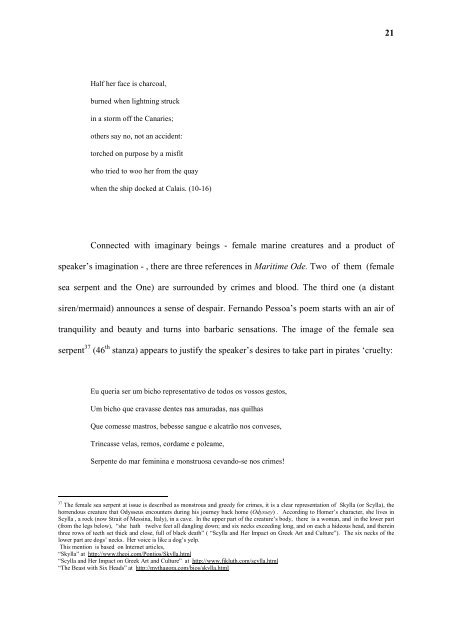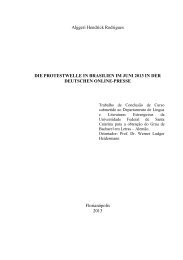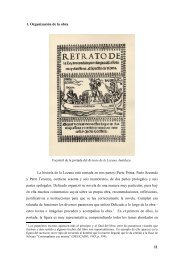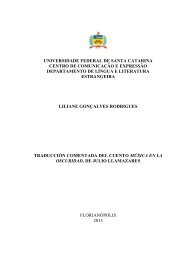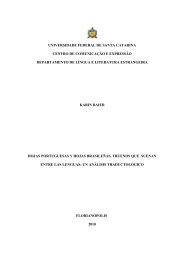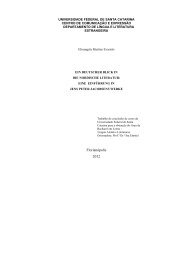TCC - Marcia Regina Barreto Moraes - Departamento de Língua e ...
TCC - Marcia Regina Barreto Moraes - Departamento de Língua e ...
TCC - Marcia Regina Barreto Moraes - Departamento de Língua e ...
Create successful ePaper yourself
Turn your PDF publications into a flip-book with our unique Google optimized e-Paper software.
Half her face is charcoal,<br />
burned when lightning struck<br />
in a storm off the Canaries;<br />
others say no, not an acci<strong>de</strong>nt:<br />
torched on purpose by a misfit<br />
who tried to woo her from the quay<br />
when the ship docked at Calais. (10-16)<br />
Connected with imaginary beings - female marine creatures and a product of<br />
speaker’s imagination - , there are three references in Maritime O<strong>de</strong>. Two of them (female<br />
sea serpent and the One) are surroun<strong>de</strong>d by crimes and blood. The third one (a distant<br />
siren/mermaid) announces a sense of <strong>de</strong>spair. Fernando Pessoa’s poem starts with an air of<br />
tranquility and beauty and turns into barbaric sensations. The image of the female sea<br />
serpent 37 (46 th stanza) appears to justify the speaker’s <strong>de</strong>sires to take part in pirates ‘cruelty:<br />
Eu queria ser um bicho representativo <strong>de</strong> todos os vossos gestos,<br />
Um bicho que cravasse <strong>de</strong>ntes nas amuradas, nas quilhas<br />
Que comesse mastros, bebesse sangue e alcatrão nos conveses,<br />
Trincasse velas, remos, cordame e poleame,<br />
Serpente do mar feminina e monstruosa cevando-se nos crimes!<br />
37 The female sea serpent at issue is <strong>de</strong>scribed as monstrous and greedy for crimes, it is a clear representation of Skylla (or Scylla), the<br />
horrendous creature that Odysseus encounters during his journey back home (Odyssey) . According to Homer’s character, she lives in<br />
Scylla , a rock (now Strait of Messina, Italy), in a cave. In the upper part of the creature’s body, there is a woman, and in the lower part<br />
(from the legs below), “she hath twelve feet all dangling down; and six necks exceeding long, and on each a hi<strong>de</strong>ous head, and therein<br />
three rows of teeth set thick and close, full of black <strong>de</strong>ath” ( “Scylla and Her Impact on Greek Art and Culture”). The six necks of the<br />
lower part are dogs’ necks. Her voice is like a dog’s yelp.<br />
This mention is based on Internet articles,<br />
“Skylla” at http://www.theoi.com/Pontios/Skylla.html<br />
“Scylla and Her Impact on Greek Art and Culture” at http://www.fjkluth.com/scylla.html<br />
“The Beast with Six Heads” at http://mythagora.com/bios/skylla.html<br />
21


